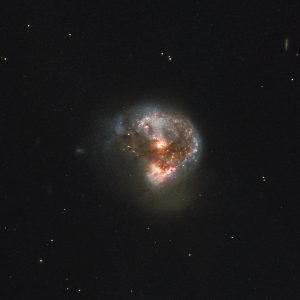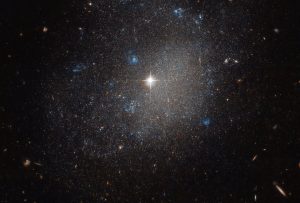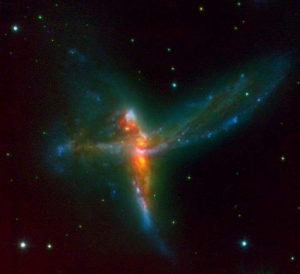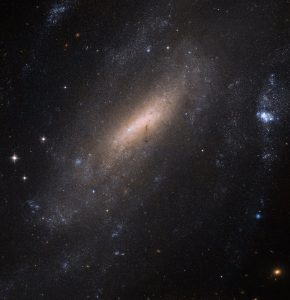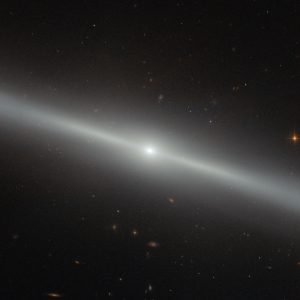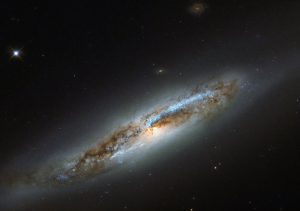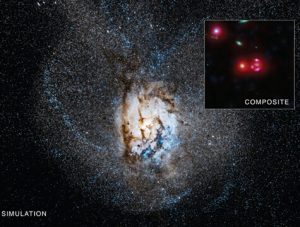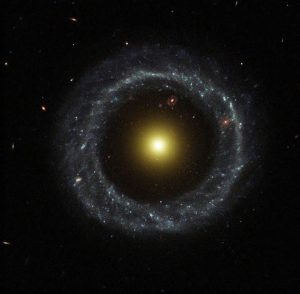galassia
Megamaser
Questa galassia ha la più divertente e futuristica classificazione di tutte: è un megamaser! I megamaser sono maser 100 milioni di volte più luminosi di quelli che si trovano nella nostra galassia, la Via Lattea. L’intera galassia, in quel caso, agisce praticamente come un laser di dimensioni astronomiche che non emette luce bensì microonde (maser è come laser ma con la M di microonde anzichè la L di luce). Continua a leggere
Una Rosa di Galassie

Questa straordinaria immagine ripresa dal telescopio Hubble mostra uno spettacolare insieme di galassie interagenti chiamato Arp 273. La grande galassia a spirale in alto, nota come UGC 1810, presenta un disco che forma un’incredibile struttura simile ad una rosa, distorto dall’azione gravitazionale della sua compagna sottostante, UGC 1813.
Puntinismo stellare
In una limpida notte dell’aprile 1789 l’astronomo William Herschel, mentre proseguiva la sua inarrestabile esplorazione del cielo notturno, individuò un nuovo oggetto cosmico ed ebbe occasione di festeggiare! Incrementando la sua lista straordinaria di scoperte ancora una volta, l’astronomo osservò questa brillante galassia a spirale, chiamata NGC 4707, nella costellazione dei Cani da Caccia. NGC 4707 si trova a circa 22 milioni di anni luce dalla Terra. Continua a leggere
Una Fatina Cosmica
Utilizzando il Very Large Telescope dell’ESO, un team internazionale di astronomi ha individuato uno splendido, raro caso di triplice fusione di galassie. Questo sistema, che gli astronomi hanno soprannominato L’Uccello (“The Bird”), anche se potrebbe assomigliare ad una fatina Trilly cosmica, si compone di due galassie a spirale massicce e una terza galassia irregolare. Continua a leggere
La Galassia Ruota di Carro
A circa 500 milioni di anni luce di distanza nella costellazione dello Scultore, la forma della Galassia Ruota di Carro (Cartwheel Galaxy) è il risultato di una collisione galattica violenta. Una galassia più piccola è passata attraverso il disco di una grande galassia e ha prodotto onde d’urto che hanno travolto gas e polveri, in modo simile alle increspature prodotte quando un sasso cade in un lago. Lo scontro titanico ha innescato nella regione intensi fenomeni di formazione stellare. Continua a leggere
Uno sguardo ravvicinato a IC 5201
Nel 1900, utilizzando un telescopio all’Osservatorio di Cape Town in Sudafrica, l’astronomo Joseph Lunt ha individuato nella costellazione meridionale della Gru questo oggetto affascinante: una galassia a spirale barrata che ora si chiama IC 5201. Continua a leggere
NGC 4762: Una Scia Luminosa in Cielo
Questa straordinaria immagine del telescopio Hubble immortala una sorprendente galassia visibile di taglio, NGC 4762, tanto che appare simile ad una scia luminosa che percorre un silenzioso cammino nelle profondità del cosmo. Continua a leggere
Metamorfosi nella Vergine
Questa volta l’obiettivo del telescopio Hubble è una galassia molto particolare, NGC 4388, soggetta suo malgrado ad una trasformazione radicale che ne ha alterato l’intera struttura, quasi si trattasse di una vera e propria metamorfosi. Continua a leggere
Tripudio di stelle in una lontana galassia
Una galassia distante, scoperta recentemente, si illumina del bagliore di una quantità straordinaria di stelle neonate, formandole ad un ritmo forsennato. La prolifica galassia, chiamata SPT 0346-52, si trova a 12,7 miliardi di anni luce dalla Terra ed è stata quindi osservata circa un miliardo di anni dopo il Big Bang. Continua a leggere
L’Oggetto di Hoag
Un anello quasi perfetto di calde stelle blu disposte attorno al nucleo giallastro di una galassia insolita: è l’Oggetto di Hoag. L’intera galassia si estende in ampiezza per circa 120.000 anni luce, leggermente più grande della nostra Via Lattea. L’anello blu è dominato dalla presenza di gruppi di giovani stelle massicce, in netto contrasto con il nucleo di colore giallo composto da stelle per lo più vecchie. Continua a leggere
